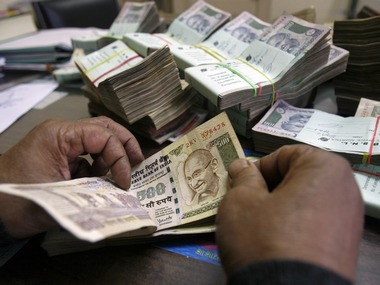Trust our policymakers and analysts to start uncorking the champagne at the first signs of a revving of the economic engine…
India, reasons a Credit Suisse analysis, is on the cusp of a “brand new economic cycle”. Over the next few months, it reasons, “we should see further falls in wholesale price inflation and interest rates, together with a decline in the twin deficits and mounting evidence of the long-awaited economic recovery.” And although it caveats this by noting that the country’s “myriad structural issues” still persisted, the tone is one of premature celebration.
It’s a theme that resonates in Planning Commission Deputy Chairman Montek Singh Ahluwalia’s observations in an interview to Business Line, wherein he states: “My own judgment is that the economy has begun to turn around and we have unutilised growth capacity.”
It’s true, of course, in a broad sense that the economy is close to bottoming out, and the consensus view is that a mild recovery could take effect from the June quarter. The RBI appears to be taking its foot off the brake pedal, instilling hopes that the interest rate environment will turn a bit more benign. And with Finance Minister P Chidambaram’s smoke-and-mirrors budget momentarily lifting the cloud of a sovereign rating downgrade, portfolio inflows have kept pace in sufficient quantities to finance the extraordinarily high current account deficit.
[caption id=“attachment_690247” align=“alignleft” width=“380”]  India is at risk of misdiagnosing its economic problems. Reuters[/caption]
And, yet, the very real prospects of a misdiagnosis of the underlying ailment - and a blase complacence that is never far from the surface - put this economic recovery at risk.
Virtually every estimate that forecasts a gradual fall in the current account deficit rests on exceedingly optimistic scenarios that don’w give allowances for downside risks. The continued weakness of real exports is inexplicable, but analysts have airily dismissed as a laggard that will get back in line soon.
Ahluwalia trots out just such a rosy scenario for the current account deficit. In his characterisation, the “exceptionally high levels of gold imports” are to blame for the high current account deficit, but with a decline in the global price of gold in recent times, he reckons, a turnaround is inevitable. “In recent years, gold prices globally have risen and, of course, the rupee has also been under pressure, and the two together probably increased the demand for gold as an asset. Things may be turning around,” he noted.
“Globally, the price of gold is actually now going down. The perception that the rupee could weaken has been driving gold demand but as the current account comes under control, that will correct itself,” he reasons.
More generally, Ahluawalia says, there is a “lot of liquidity in the world economy and India is still seen as one of the countries whose economic performance could be quite good. Much will depend on whether people see that the economy is well-managed and is turning around.”
Such excessively optimistic projections on the part of policymakers have in recent years tripped up the economy far more seriously than the underlying fundamentals perhaps warranted. As Firstpost has noted earlier, this style of economic policymaking reflects the cheerily optimistic personality of the character Wilkins Micawber, immortalised by the writer Charles Dickens in David Copperfield.
Micawber lives in eternal indebtedness but gets by on the strength of his faith that “something will turn up” to bail him out of his troubles. As Finance Minister in recent years, Pranab Mukherjee was famous for budgeting in only for best-case macroeconomic scenarios, even if he was proved consistently wrong in his estimations. And even Chidambaram’s roadmap to fiscal consolidation rests on the premise that the UPA government will abide by its plans to do away with diesel subsidy over an 18-month period through gradual increases in diesel prices. That commitment will be severely tested in the election season, which will be upon us anytime over the next 12 months.
More seriously, argues CLSA economist Rajeev Malik, there is a very real risk that India’s policymakers are misdiagnosing the disease, and could end up repeating the same mistakes of the recent past in the matter of exchange rate management. No other Asian country, he notes, comes closse to India in having “misdiagnosed its economic problems, committed egregious policy boo-boos, perferred band-aids instead of lasting cures, and treated symptoms rather than the underlying disease.” And in his estimation, the misdiagnosis continues in, for instance, the exchange rate management.
The RBI’s hands-off policy on rupee management since 2008 induced a “misaligment” in the rupee value, which went without triggering alarm bells because capital inflows were financing the wider current account deficit. That meant policymakers ignored the need to offset India’s high inflation differential with its trading partners; it needed a significant depreciation of the rupee from 2011 to remedy this misalignment, argues Malik.
And even today, the same risks abound. The delusion that the nominal exchange rate is stable - because portfolio inflows are high enough to finance the current account deficit - “misses the crucial point about the the need for rupee weakness” to offset the high inflation differential with its trading partners.
Only a weaker rupee - and broad-sweep structural reforms - can boost India’s competitiveness, and the government’s “misguided approach” towards the rupee only has the effect of kicking the can down the road, he cautions.
There is much merit in that argument. While it is doubtless true that a cyclical recovery is on the horizon, it is folly to read too much into it - and avoid the painful but necessary structural reforms that have been put off for too long. The laws of economics have a karmic quality about them: you can’t escape the consequences of your bad actions. Failure to take the bitter medicine now will inevitably mean having to subject oneself to even greater pain later.


)
)
)
)
)
)
)
)
)



